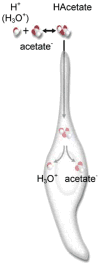Signal transduction and information processing in mammalian taste buds
- PMID: 17468883
- PMCID: PMC3723147
- DOI: 10.1007/s00424-007-0247-x
Signal transduction and information processing in mammalian taste buds
Abstract
The molecular machinery for chemosensory transduction in taste buds has received considerable attention within the last decade. Consequently, we now know a great deal about sweet, bitter, and umami taste mechanisms and are gaining ground rapidly on salty and sour transduction. Sweet, bitter, and umami tastes are transduced by G-protein-coupled receptors. Salty taste may be transduced by epithelial Na channels similar to those found in renal tissues. Sour transduction appears to be initiated by intracellular acidification acting on acid-sensitive membrane proteins. Once a taste signal is generated in a taste cell, the subsequent steps involve secretion of neurotransmitters, including ATP and serotonin. It is now recognized that the cells responding to sweet, bitter, and umami taste stimuli do not possess synapses and instead secrete the neurotransmitter ATP via a novel mechanism not involving conventional vesicular exocytosis. ATP is believed to excite primary sensory afferent fibers that convey gustatory signals to the brain. In contrast, taste cells that do have synapses release serotonin in response to gustatory stimulation. The postsynaptic targets of serotonin have not yet been identified. Finally, ATP secreted from receptor cells also acts on neighboring taste cells to stimulate their release of serotonin. This suggests that there is important information processing and signal coding taking place in the mammalian taste bud after gustatory stimulation.
Figures






Similar articles
-
CALHM1 ion channel mediates purinergic neurotransmission of sweet, bitter and umami tastes.Nature. 2013 Mar 14;495(7440):223-6. doi: 10.1038/nature11906. Epub 2013 Mar 6. Nature. 2013. PMID: 23467090 Free PMC article.
-
A physiologic role for serotonergic transmission in adult rat taste buds.PLoS One. 2014 Nov 11;9(11):e112152. doi: 10.1371/journal.pone.0112152. eCollection 2014. PLoS One. 2014. PMID: 25386961 Free PMC article.
-
Using biosensors to detect the release of serotonin from taste buds during taste stimulation.Arch Ital Biol. 2005 May;143(2):87-96. Arch Ital Biol. 2005. PMID: 16106989 Free PMC article.
-
Taste transduction and channel synapses in taste buds.Pflugers Arch. 2021 Jan;473(1):3-13. doi: 10.1007/s00424-020-02464-4. Epub 2020 Sep 16. Pflugers Arch. 2021. PMID: 32936320 Free PMC article. Review.
-
Taste receptor signalling - from tongues to lungs.Acta Physiol (Oxf). 2012 Feb;204(2):158-68. doi: 10.1111/j.1748-1716.2011.02308.x. Epub 2011 May 7. Acta Physiol (Oxf). 2012. PMID: 21481196 Free PMC article. Review.
Cited by
-
Changes in taste receptor cell [Ca2+]i modulate chorda tympani responses to bitter, sweet, and umami taste stimuli.J Neurophysiol. 2012 Dec;108(12):3221-32. doi: 10.1152/jn.00129.2012. Epub 2012 Sep 19. J Neurophysiol. 2012. PMID: 22993258 Free PMC article.
-
Understanding the impact of taste changes in oncology care.Support Care Cancer. 2016 Apr;24(4):1917-31. doi: 10.1007/s00520-016-3083-8. Epub 2016 Jan 28. Support Care Cancer. 2016. PMID: 26820877 Review.
-
The K+ channel KIR2.1 functions in tandem with proton influx to mediate sour taste transduction.Proc Natl Acad Sci U S A. 2016 Jan 12;113(2):E229-38. doi: 10.1073/pnas.1514282112. Epub 2015 Dec 1. Proc Natl Acad Sci U S A. 2016. PMID: 26627720 Free PMC article.
-
Ionotropic Receptors Mediate Drosophila Oviposition Preference through Sour Gustatory Receptor Neurons.Curr Biol. 2017 Sep 25;27(18):2741-2750.e4. doi: 10.1016/j.cub.2017.08.003. Epub 2017 Sep 7. Curr Biol. 2017. PMID: 28889974 Free PMC article.
-
The gustatory cortex and multisensory integration.Int J Obes (Lond). 2009 Jun;33 Suppl 2(Suppl 2):S34-43. doi: 10.1038/ijo.2009.70. Int J Obes (Lond). 2009. PMID: 19528978 Free PMC article. Review.
References
-
- Simon SA, de Araujo I, Gutierrez R, Nicolelis MA. The neural mechanisms of gustation: a distributed processing code. Nat Rev Neurosci. 2006;7:890–901. - PubMed
-
- Meyerhof W. Elucidation of mammalian bitter taste. Rev Physiol Biochem Pharmacol. 2005;154:37–72. - PubMed
-
- Spector AC, Travers SP. The representation of taste quality in the mammalian nervous system. Behav Cogn Neurosci Rev. 2005;4:143–191. - PubMed
-
- Breslin PA, Huang L. Human taste: peripheral anatomy, taste transduction, and coding. Adv Oto-Rhino-Laryngol. 2006;63:152–190. - PubMed
-
- Gilbertson TA. Gustatory mechanisms for the detection of fat. Curr Opin Neurobiol. 1998;8:447–452. - PubMed
Publication types
MeSH terms
Substances
Grants and funding
LinkOut - more resources
Full Text Sources
Other Literature Sources

